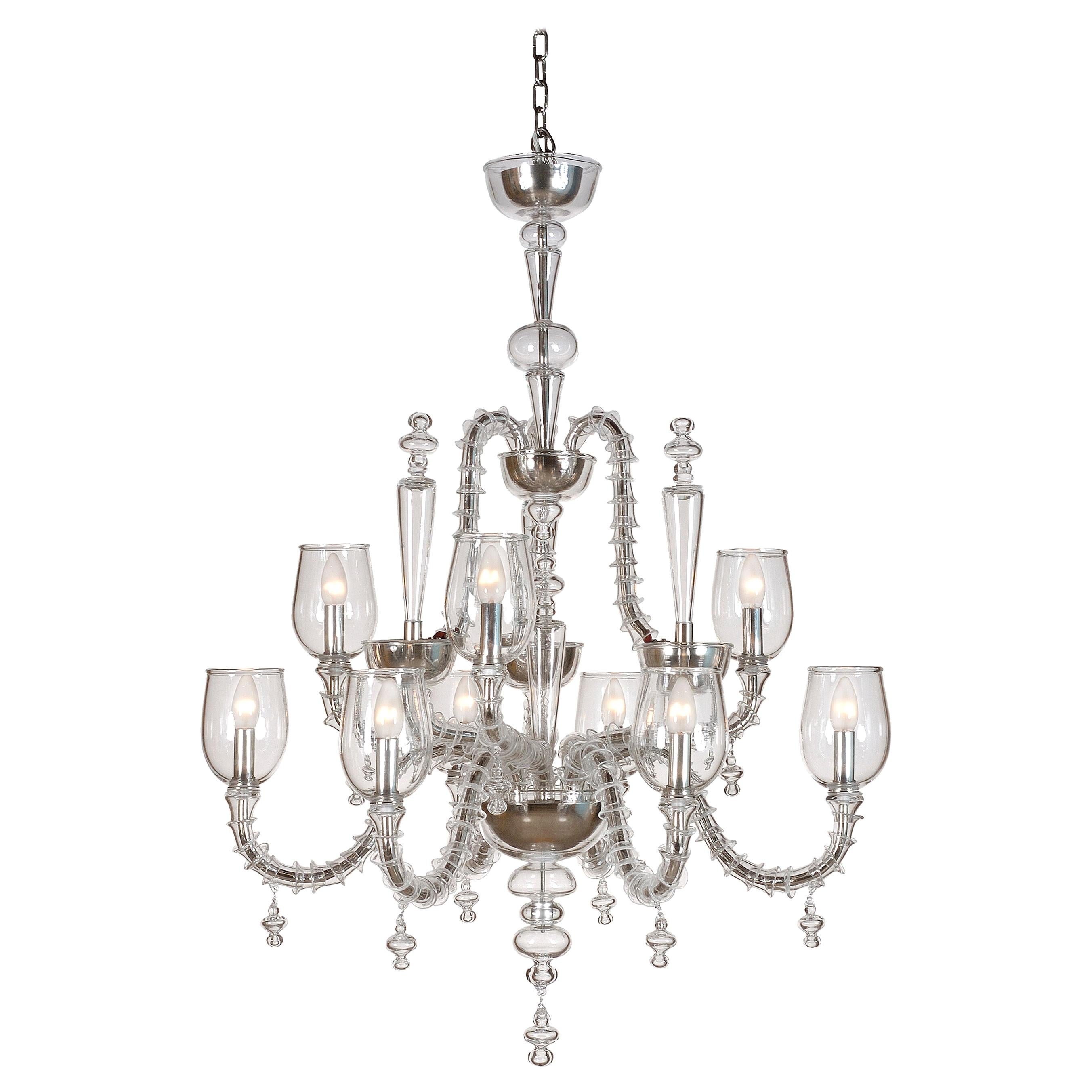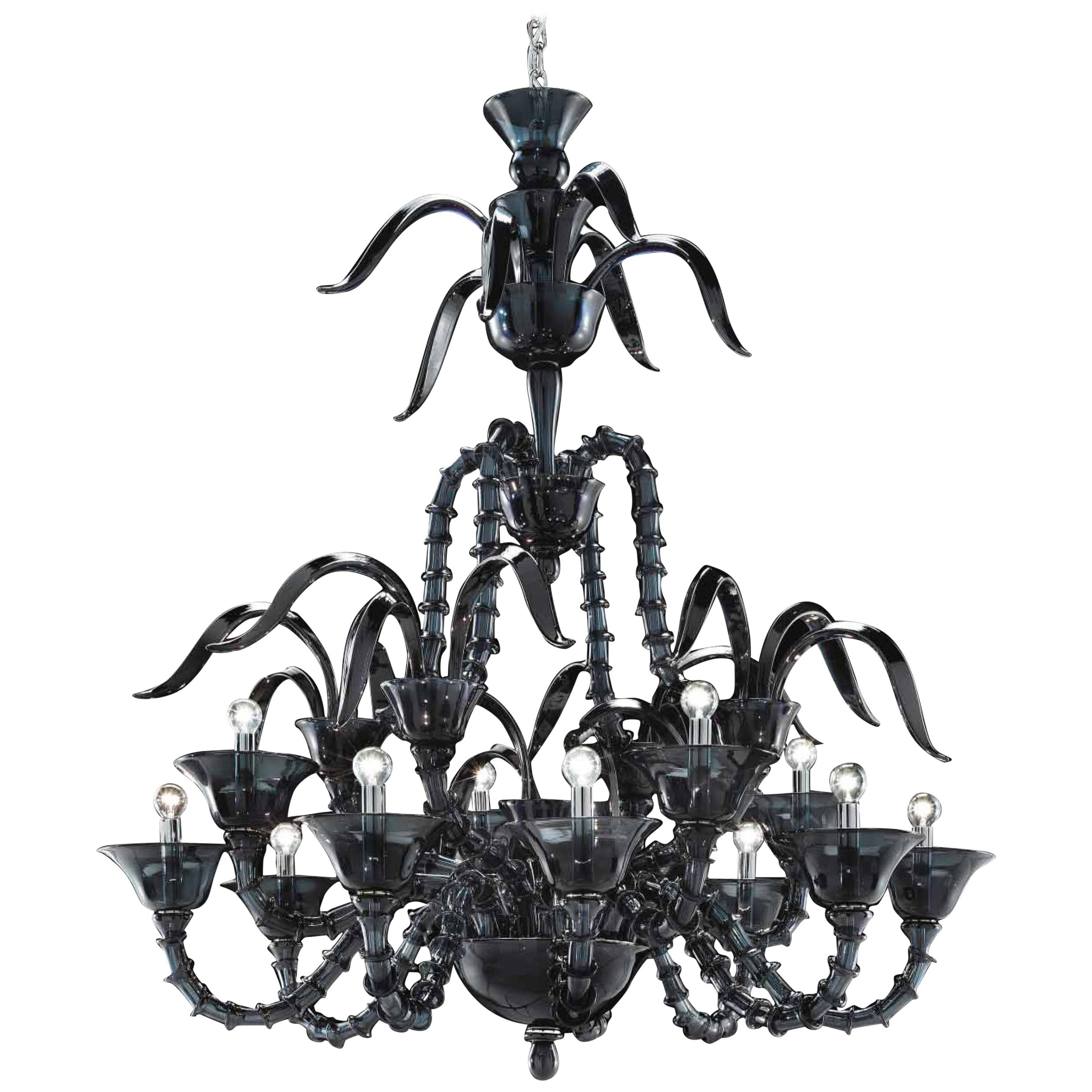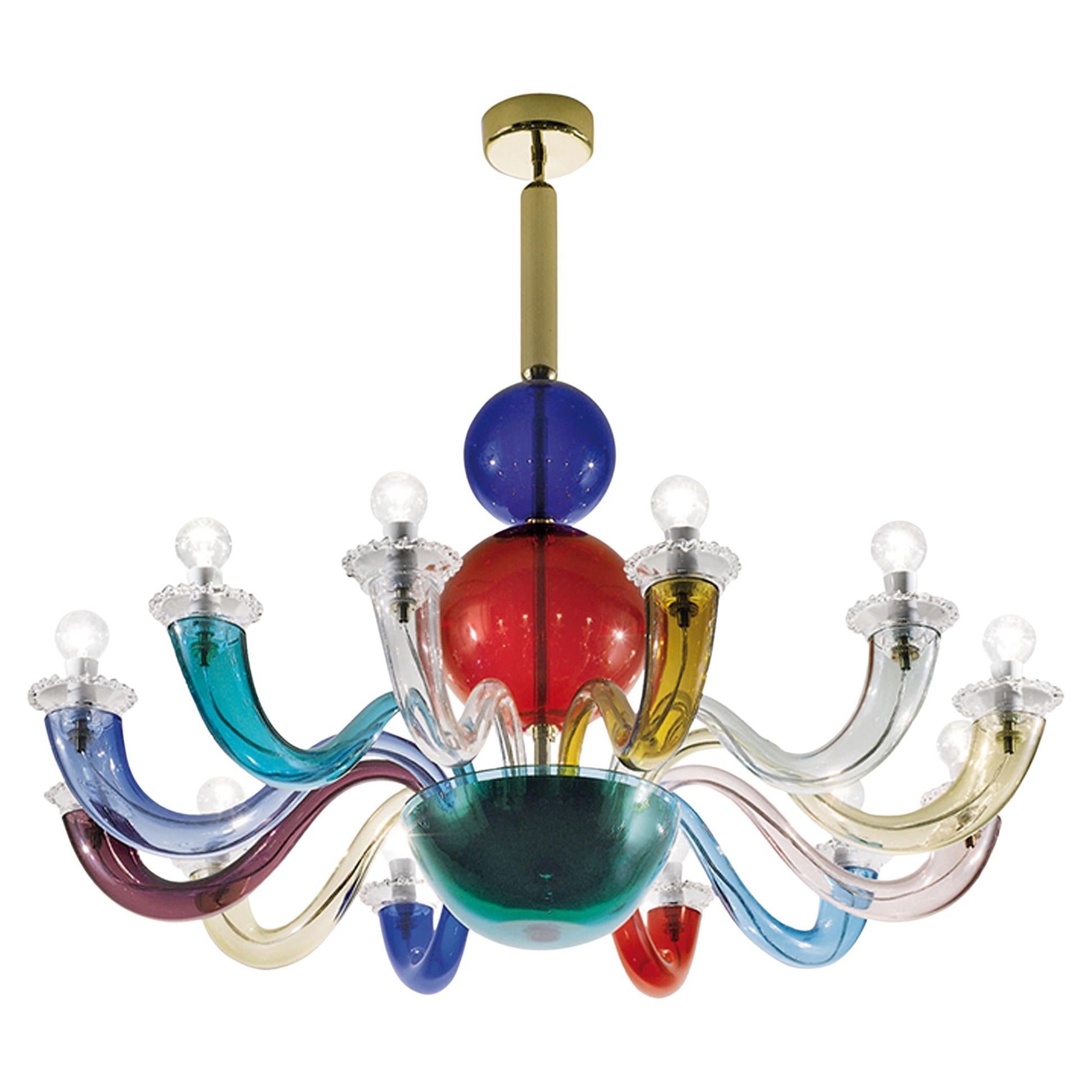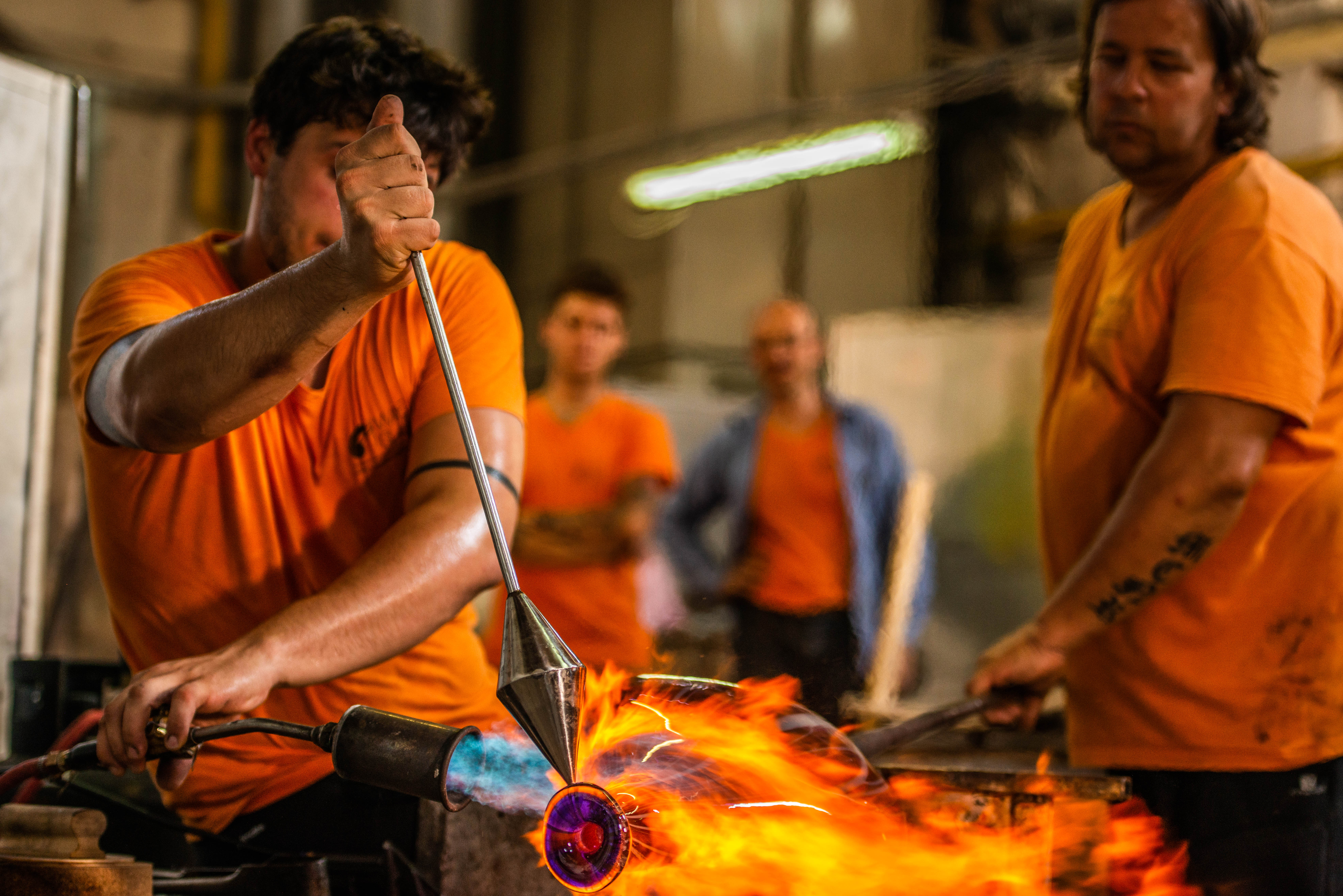Items Similar to Authentic Venetian Classic Chandelier Handmade in Murano Glass
Want more images or videos?
Request additional images or videos from the seller
1 of 9
Authentic Venetian Classic Chandelier Handmade in Murano Glass
About the Item
Add a touch of timeless elegance to your home decor with this exquisite Venetian classic chandelier, expertly handmade in Murano glass. Featuring six lights, this chandelier is a true masterpiece created by skilled Murano masterglass artisans, using traditional techniques passed down through generations.
Each piece is unique, as the handcrafted nature of the process ensures no two chandeliers are exactly alike. This chandelier is a true testament to the quality and craftsmanship of Murano glass, renowned worldwide for its beauty and sophistication.
With its classic design and luxurious appeal, this Venetian chandelier is a statement piece that will elevate any space. Ideal for formal dining rooms, grand entryways, and luxurious living rooms, this chandelier is sure to impress your guests and become a cherished addition to your home.
Crafted with care and attention to detail, this authentic Venetian classic chandelier is made in our factory in Murano, Venice Italy. It features a beautiful green and violet color combination, adding a pop of color and personality to your space.
Don't miss out on the opportunity to own your piece of Venetian artistry, crafted with care and attention to detail. Order your Murano glass chandelier today and add a touch of Italian elegance to your home.
Color: Green and violet
Hardware : Chrome
Dimension : 85 x 75cm
This chandelier can be customized upon request.
- Creator:Roberto Beltrami (Manufacturer)
- Dimensions:Height: 33.47 in (85 cm)Diameter: 29.53 in (75 cm)
- Style:Modern (In the Style Of)
- Materials and Techniques:
- Place of Origin:
- Period:
- Date of Manufacture:2020
- Production Type:New & Custom(Current Production)
- Estimated Production Time:3-4 weeks
- Condition:
- Seller Location:Murano, IT
- Reference Number:1stDibs: LU3765122515102
Wave Murano Glass
Wave Murano Glass is the new start-up born on the Murano island. Founded in 2017, the company quickly drew attention on the market for its products originality and its capacity to create new shapes and concepts with an old material. Wave Murano Glass distinguishes itself by having in charge of the company a Glass Master and Chief of production who’s also a physicist. It’s Roberto Beltrami, the first under-30 talent of the island who, along with a small team of glass-blowers and bevellers, offers made-to-measure collection, vase, lighting fixture, unique and exclusive furniture on the market. Scientific, technical and artistic skills make of Roberto Beltrami an experienced and reliable person differentiating him from other Murano island masters. Wave Murano Glass experiments all creative possibilities that glass can offers satisfying any type of request of customization from clients. Flexibility, research, movement and change are part of the company philosophy and are reflected in the related offers. Renowned luxury brands have already put their trust in Wave Murano Glass. The design and production team are dedicated to customized projects in the entire world and is able to turn any habitual request from architects and designers into a unique and finished product. Any “dream” can be realized in glass.
Sizes, Colors, nr of Lights
About the Seller
5.0
Vetted Seller
These experienced sellers undergo a comprehensive evaluation by our team of in-house experts.
Established in 2017
1stDibs seller since 2018
62 sales on 1stDibs
Typical response time: 2 hours
- ShippingRetrieving quote...Ships From: Murano, Italy
- Return PolicyThis item cannot be returned.
More From This SellerView All
- Authentic Venetian Modern Design Chandelier, Handmade in Murano GlassBy Roberto BeltramiLocated in Murano, VEAdd a touch of elegance to your home decor with this exquisite Venetian modern chandelier, expertly handmade in Murano glass. Featuring six lights, thi...Category
2010s Italian Modern Chandeliers and Pendants
MaterialsBlown Glass
- Artistic Handmade Ca' Rezzonico Murano Glass ChandelierBy Roberto BeltramiLocated in Murano, VEThe Rezzonico is one of the oldest styles of Murano glass chandeliers. Its peculiarity lies in its composition. Each arm is composed of pieces of glass that assemble the chandelier. ...Category
2010s Italian Modern Chandeliers and Pendants
MaterialsBlown Glass
- Artistic Handmade Design Ca' Rezzonico Murano Glass ChandelierBy Roberto BeltramiLocated in Murano, VEDiscover the timeless elegance of Rezzonico style chandeliers, one of the oldest and most beloved chandelier designs made in Murano, here in a modern transparent version. The peculia...Category
2010s Italian Modern Chandeliers and Pendants
MaterialsBlown Glass
- Artistic Handmade Design Ca' Rezzonico New York Murano Glass ChandelierBy Roberto BeltramiLocated in Murano, VEDiscover the timeless elegance of Rezzonico style chandeliers, one of the oldest and most beloved chandelier designs made in Murano. The peculiarity of this style is its exquisite co...Category
2010s Italian Modern Chandeliers and Pendants
MaterialsBlown Glass
- Chandelier Rezzonico Style with 24 Lights in Murano Glass and 3D PrintBy Roberto BeltramiLocated in Murano, VEThe Silver Sprout heralds a new era for chandeliers. Entirely hand-blown by our company's glass masters, Wave Murano Glass presents a futuristic twist on this classic Murano art for...Category
2010s Italian Modern Chandeliers and Pendants
MaterialsBlown Glass
- Artistic Handmade Murano Glass Sculpture Aquamarine TurtleBy Roberto BeltramiLocated in Murano, VEImmerse yourself in the beauty of our modern artistic aquatic turtle sculpture, entirely handmade with precision in authentic Murano glass. Each exquisite detail is meticulously craf...Category
2010s Italian Modern Figurative Sculptures
MaterialsMurano Glass
You May Also Like
- Murano handmade blown glass chandelier design by Gio Ponti for VENINI OfficialBy VeniniLocated in murano, ITThe desire to make a stylistic renewal, while remaining faithful to the fine craftsmanship of the Italian tradition, constitutes the solid basis on which the perfect collaboration between the Venini company and the designer Gio Ponti is founded And it is from this synergy that the Gio Ponti 99.80 series was created in 1946: the combination of clean lines and bright colours still make it a classic appreciated by connoisseurs all over the world Its absolute originality derives from the alternation of curved arms, each in glass of a different colour. “Everything in the world must be full of colour” - Gio Ponti Blown glass chandelier consisting of two spherical elements coloured red and sapphire, transparent coloured glass arms and green bottom...Category
21st Century and Contemporary Italian Chandeliers and Pendants
MaterialsMurano Glass
- Murano Chandelier in Red and Clear Art Glass w/ Original Glass Ceiling CanopyLocated in Kansas City, MOExceptional vintage murano blown glass six light chandelier in red and clear art glass. The clear glass pieces simply insert into the center and the shades are removable for shipping. This also retains the red art glass canopy...Category
Vintage 1970s Italian Mid-Century Modern Chandeliers and Pendants
MaterialsGlass, Art Glass, Blown Glass
- Venetian Chandelier in Murano GlassLocated in Antwerp, BEElegant decorative floral Murano glass 4-arms chandelier, Venetian style. Green/white color with flowers. Diameter 60 cm. Height fixture 55 cm. Total height 75 cm.Category
Mid-20th Century Italian Mid-Century Modern Chandeliers and Pendants
MaterialsMurano Glass
- Murano Venini Cascading Glass Prism Chandelier VintageBy VeniniLocated in North Miami, FLIn this vintage Murano Venini chandelier are five tiers of hanging prism glass pendants that make up this chandelier. It is Italian and the five le...Category
Vintage 1970s Italian Mid-Century Modern Glass
MaterialsNickel
- Classic Venetian Chandelier, Murano, 1980sBy Vintage Murano GalleryLocated in Palermo, PAOne of a kind vintage Murano chandelier, ca 1980s. The light has 5 bulbs. Five leafs and 5 striped flowers. Note that we have two chandeliers available so you have the possibility t...Category
Mid-20th Century Italian Mid-Century Modern Chandeliers and Pendants
MaterialsMetal
- Carlo Scarpa Green Poliedri Chandelier in Murano Opaline Glass for Venini, 1958By Venini, Carlo ScarpaLocated in Vicenza, IT“Poliedri” chandelier designed by Carlo Scarpa and produced by the Italian manufacturer Venini in, 1958. Made of opaline Murano glass. Born in Venice on June 2nd, 1906, Carlo Scarpa began working at a very early age. Only a year after he had first qualified as an architect in 1926, he began working for the Murano glassmakers Cappellin & Co. in a consultative capacity; from 1927, he began to experiment with the Murano glass, and this research not only gave him excellent results here but would also inform his progress for many years to come. Between 1935 and 1937, as he entered his thirties, Carlo Scarpa accepted his first important commission, the renovation of Venice’s Cà Foscari. He adapted the spaces of this stately University building which stands on the banks of the Grand Canal, creating rooms for the Dean’s offices and a new hall for academic ceremonies; Mario Sironi and Mario De Luigi were charged with doing the restoration work on the frescos. After 1945, Carlo Scarpa found himself constantly busy with new commissions, including various furnishings and designs for the renovation of Venice’s Hotel Bauer and designing a tall building in Padua and a residential area in Feltre, which are all worth mention. One of his key works, despite its relatively modest diminished proportions, was the first of many works which were to follow in the nineteen fifties: the [bookshop known as the] Padiglione del Libro, which stands in Venice’s Giardini di Castello and shows clearly Scarpa’s passion for the works of Frank Lloyd Wright. In the years which were to follow, after he had met the American architect, Scarpa repeated similar experiments on other occasions, as can be seen, in particular, in the sketches he drew up in 1953 for villa Zoppas in Conegliano, which show some of his most promising work. However, this work unfortunately never came to fruition. Carlo Scarpa later created three museum layouts to prove pivotal in terms of how twentieth-century museums were to be set up from then on. Between 1955 and 1957, he completed extension work on Treviso’s Gipsoteca Canoviana [the museum that houses Canova’s sculptures] in Possagno, taking a similar experimental approach to the one he used for the Venezuelan Pavilion at [Venice’s] Giardini di Castello which he was building at the same time (1954-56). In Possagno Carlo Scarpa was to create one of his greatest ever works, which inevitably bears comparison with two other museum layouts that he was working on over the same period, those of the Galleria Nazionale di Sicilia, housed in the Palazzo Abatellis in Palermo (1953-55) and at the Castelvecchio in Verona (1957- 1974), all of which were highly acclaimed, adding to his growing fame. Two other buildings, which are beautifully arranged in spatial terms, can be added to this long list of key works that were started and, in some cases, even completed during the nineteen fifties. After winning the Olivetti award for architecture in 1956, Scarpa began work in Venice’s Piazza San Marco on an area destined to house products made by the Industrial manufacturers Ivrea. Over the same period (1959-1963), he also worked on renovation and restoration of the gardens and ground floor of the Fondazione Querini Stampalia in Venice, which many consider being one of his greatest works. While he busied himself working on-site at the Fondazione Querini Stampalia, Carlo Scarpa also began work building a villa in Udine for the Veritti family. To shed some light on the extent to which his work evolved over the years, it may perhaps be useful to compare this work with that of his very last building, villa Ottolenghi Bardolino, which was near to completion at the time of his sudden death in 1978. Upon completion of villa Veritti over the next ten years, without ever letting up on his work on renovation and layouts, Scarpa accepted some highly challenging commissions which were to make the most of his formal skills, working on the Carlo Felice Theatre in Genoa as well as another theatre in Vicenza. Towards the end of this decade, in 1969, Rina Brion commissioned Carlo Scarpa to build the Brion Mausoleum in San Vito d’Altivole (Treviso), a piece he continued to work on right up until the moment of his death. Nevertheless, even though he was totally absorbed by work on this mausoleum, there are plenty of other episodes which can offer some insight into the final years of his career. As work on the San Vito d’Altivole Mausoleum began to lessen from 1973, Carlo Scarpa began work building the new headquarters for the Banca Popolare di Verona. He drew up plans that were surprisingly different from the work he was carrying out at the same time on the villa Ottolenghi. However, the plans Carlo Scarpa drew up, at different times, for a monument in Brescia’s Piazza della Loggia commemorating victims of the terrorist attack on May 28th, 1974, make a sharp contrast to the work he carried out in Verona, almost as if there is a certain hesitation after so many mannered excesses. The same Pietas that informs his designs for the Piazza Della Loggia can also be seen in the presence of the water that flows through the Brion Mausoleum, almost as if to give a concrete manifestation of pity in this twentieth-century work of art. Carlo Scarpa has put together a highly sophisticated collection of structures, occupying the mausoleum’s L-shaped space stretching across both sides of the old San Vito d’Altivole cemetery. A myriad of different forms and an equally large number of different pieces, all of which are separate and yet inextricably linked to form a chain that seems to offer no promise of continuity, rising up out of these are those whose only justification for being there is to bear the warning “si vis vitam, para mortem”, [if you wish to experience life prepare for death] as if to tell a tale that suggests the circle of time, joining together the commemoration of the dead with a celebration of life. At the entrance of the Brion Mausoleum stand the “propylaea” followed by a cloister which ends by a small chapel, with an arcosolium bearing the family sarcophagi, the main pavilion, held in place on broken cast iron supports, stands over a mirror-shaped stretch of water and occupies one end of the family’s burial space. The musical sound of the walkways teamed with the luminosity of these harmoniously blended spaces shows how, in keeping with his strong sense of vision, Carlo Scarpa could make the most of all of his many skills to come up with this truly magnificent space. As well as a great commitment to architectural work, with the many projects which we have already seen punctuating his career, Carlo Scarpa also made many equally important forays into the world of applied arts. Between 1926 and 1931, he worked for the Murano glassmakers Cappellin, later taking what he had learned with him when he went to work for the glassmakers Venini from 1933 until the 1950s. The story of how he came to work on furniture design is different, however, and began with the furniture he designed to replace lost furnishings during his renovation of Cà Foscari. The later mass-produced furniture started differently, given that many pieces were originally one-off designs “made to measure”. Industrial manufacturing using these designs as prototypes came into being thanks to the continuity afforded him by Dino Gavina, who, as well as this, also invited Carlo Scarpa to become president of the company Gavina SpA, later to become SIMON, a company Gavina founded 8 years on, in partnership with Maria Simoncini (whose own name accounts for the choice of company name). Carlo Scarpa and Gavina forged a strong bond in 1968 as they began to put various models of his into production for Simon, such as the “Doge” table, which also formed the basis for the “Sarpi” and “Florian” tables. In the early seventies, other tables that followed included “Valmarana”, “Quatour” and “Orseolo”. While in 1974, they added couch and armchair “Cornaro” to the collection and the “Toledo” bed...Category
Vintage 1950s Italian Mid-Century Modern Chandeliers and Pendants
MaterialsGlass, Murano Glass
Recently Viewed
View AllMore Ways To Browse
Chandelier Classic
Classic Pendant Lighting
Handmade Glass Lighting
Handmade Chandelier
Handmade Modern Chandelier
Venetian Chandelier
Venetian Chandeliers
Venetian Glass Chandelier
Handmade Glass Chandelier
Venetian Glass Chandeliers
Italian Venetian Glass Chandelier
Venetian Glass Italian Chandelier
Nature Chandelier
Venetian The Chandeliers
Traditional Glass Chandelier
Murano Venetian Chandelier
Venetian Chandelier Murano
Murano Venetian Glass Chandelier






